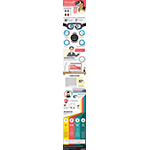DENVER--(BUSINESS WIRE)--Only two percent of teachers have used virtual reality* in the classroom, but 60 percent are interested in making it part of the learning experience, according to research released at ISTE 2016 today by Samsung Electronics America, Inc. and GfK. While virtual reality is still a relatively new technology, teachers nationwide recognize its potential to impact education.
This nationwide survey of more than 1,000 U.S. K-12 teachers revealed that 86 percent feel it is a challenge to keep students engaged in curriculum, even with existing classroom technology. Meanwhile, 93 percent of teachers say their students would be excited to use virtual reality and 83 percent say that virtual reality might help improve learning outcomes – from better understanding of learning concepts (77 percent) to greater collaboration (71 percent) and motivation in the classroom (84 percent).
“As we saw with Chromebooks, tablets, digital curriculum and game-based learning, emerging technologies can have a profound impact on student success and virtual reality has the potential do the same and more,” said Ted Brodheim, vice president of Vertical Business at Samsung Electronics America. “Samsung is committed to empowering students and teachers through technology, and we’re excited to work with educators to create new learning opportunities with virtual reality.”
According to the survey, science (82 percent), social studies (81 percent) and history (81 percent) are the top three subjects teachers think can most benefit from virtual reality. Also, the majority of teachers believe they could use virtual reality in variety of ways:
- More than two-thirds (68 percent) of teachers say they want to use virtual reality to supplement course curriculum to help students better understand course concepts, like watching a book’s video trailer for a literature lesson or viewing a chemical reaction for a science lesson.
- 7 out of 10 teachers (72 percent) want to simulate experiences relevant to course content, like flying as the Wright Brothers did in 1903 or trading stocks on the floor of a stock exchange.
- 69 percent say they would use virtual reality to travel to distant world landmarks, like Stonehenge or Machu Picchu.
- 68 percent want to use virtual reality to explore otherwise inaccessible locations, like outer space or the interior of a volcano.
- 42 percent of high school teachers (grades 9-12) would like to use virtual reality to tour college campuses to encourage students to pursue higher education.
Teachers across generations have a positive perception of technology in the classroom. However, millennial teachers are more likely to say they are “innovators” in the use of classroom technology – 79 percent, compared to 67 percent of Gen Xers and 57 percent of Baby Boomers. Also, more millennial teachers report having already experienced virtual reality for personal or professional purposes (22 percent), compared to Gen Xers and Baby Boomers (both 15 percent).
For additional details on the research, an infographic detailing the survey findings is available at: http://www.slideshare.net/SamsungBusinessUSA/.
For more information about Samsung K-12 products and solutions, please visit: www.samsung.com/education. Join the conversation on Twitter at @SamsungEDU.
The survey was conducted between May 20 and June 2, 2016, using the GfK KnowledgePanel, and included a representative sample of 1,011 K-12 teachers nationwide. The respondents were selected using random probability address-based sampling. The survey took 6 minutes on average to administer. Final data were weighted by age, gender, race/ethnicity, level of completed education, and type of school (public school teachers vs. private/charter school teachers) according to the 2012 NCES data. Age, gender, and race/ethnicity were also weighted within school type (public vs. private/charter). The margin of error for the sample is +/- 3.4 percentage points (total weighted teacher sample).
*Samsung Gear VR is not for use by children under 13. Watching videos or playing games with the Gear VR may affect the visual development of children. When children, age 13 or older, use the Gear VR, adults should limit their usage time and ensure they take frequent breaks. Adults should monitor children closely after using the Gear VR if children feel discomfort.
About Samsung Electronics America, Inc.
Headquartered in Ridgefield Park, NJ, Samsung Electronics America, Inc. (SEA), is a recognized innovation leader in consumer electronics design and technology. A wholly owned subsidiary of Samsung Electronics Co., Ltd., SEA delivers a broad range of digital consumer electronics, IT and home appliance products. Samsung is the market leader for HDTVs in the U.S and America’s fastest growing home appliance brands. To discover more of the award-winning products you love with Samsung, please visit www.samsung.com and for the latest Samsung news, please visit news.samsung.com/us and follow on Twitter @SamsungNewsUS.




